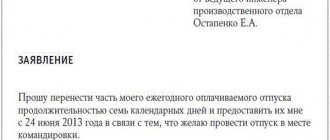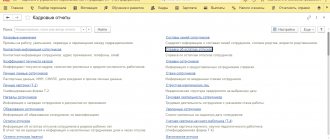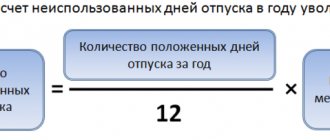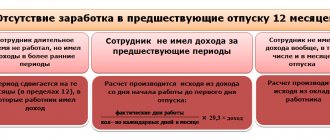How is leave granted during part-time work?
Chapter 19 of the Labor Code of the Russian Federation regulates the provision of leave to citizens. The annual basic leave is 28 days, except in cases where it can be increased.
Thus, according to Art. 115 of the Labor Code of the Russian Federation, the law does not provide for less than 28 days of vacation for a full year of work.
Accordingly, employees who work part-time are also entitled to 28 days of rest. This is confirmed by Art.
93 of the Labor Code of the Russian Federation, which prohibits introducing any restrictions for citizens who work in a mode other than the standard one.
Leave for part-time work is granted in the same way as for part-time work:
Articles on the topic (click to view)
- Fine for late payment of vacation pay
- What to do with unused vacation
- What to do if your employer does not pay vacation pay
- How long after employment is vacation allowed?
- Is maternity leave taken into account when calculating pensions?
- Accounting for compensation for unused vacation
- Dismissal while on maternity leave
- The employee writes a statement, having previously calculated the vacation period.
- The application is endorsed by the employee's immediate supervisor.
- The HR department checks the correctness of the employee's calculation of the duration of vacation and submits the document to the head of the enterprise for signature.
- An order is issued, which the employee reads and signs.
Part-time leave
Part-time working hours are established by agreement between the parties both upon hiring and subsequently, when the employee is already working in the organization (Article 93 of the Labor Code of the Russian Federation). Part-time work includes a part-time work day (or shift), a part-time work week, or a combination.
The employer is obliged to establish a part-time working day (or shift), a part-time working week at the request of:
- pregnant woman;
- one of the parents (or guardian, trustee) who has a child under the age of fourteen years (or a disabled child under the age of eighteen);
- a person who cares for a sick family member in accordance with the issued medical report in the manner established by federal laws or other regulatory legal acts of the Russian Federation.
If an employee works part-time, payment for work is made in proportion to the time worked or depending on the volume of work performed. It is important to consider that part-time work does not affect the duration of the main annual paid leave, the calculation of length of service and other labor rights of the employee.
Personnel officer's memo. List of documents
Let's look at how to calculate vacation pay for part-time work, and how to determine the vacation period. Vacation length for part-time workers is calculated in the same way as for regular workers who work full-time or a week (Article 93 of the Labor Code of the Russian Federation). The length of service includes all the same periods as for other employees. All working days and weekends established for part-time work are counted towards the actual time worked.
The employee works 5 hours three days a week. Vacation experience includes all working days, regardless of their duration, and all weekends. If the working year for such an employee began on June 1, 2021, in the absence of non-accountable periods, for example, vacation taken at his own expense, if its duration exceeds 14 calendar days, the year ends for the employee on May 31, 2021. That is, the employee will receive a full vacation, the duration of which is at least 28 calendar days.
Vacation for shortened working hours is calculated according to the same rules. Let us remind you that part-time work is established by agreement of the parties and is paid in proportion to the time worked. Reduced time can be introduced only on the basis of legal norms; payment is made as for full time (with the exception of payment for the working time of minors).
An expert from Sistema Personnel will tell you how to determine the working year and calculate the length of service that gives an employee the right to annual basic leave. In the article you will find all the periods that are included and not included in the vacation period.
Duration of vacation for part-time work
Leave for part-time work is provided in the same way as for all other employees. Its duration is at least 28 calendar days (Article 93 of the Labor Code of the Russian Federation, 115 of the Labor Code of the Russian Federation). The exception is seasonal and temporary workers. They are given two days of vacation for each month of work.
Nina Kovyazina, Deputy Director of the Department of Medical Education and Personnel Policy in Healthcare of the Ministry of Health, will tell you how to correctly determine the length of leave.
Watch video now
Reasons for providing preferential working conditions
There are two reasons for reducing working hours:
- Due to production (technological or organizational) conditions, the organization has the right to propose a transition to a part-time mode. This is done to avoid staff reductions and only with the consent of the representative (trade union) body. The maximum period for transition to these conditions is six months.
- At the request of certain categories of employees:
- pregnant women;
- parents of children under 14 years of age (disabled persons under 18), including those on registered parental leave;
- workers caring for a temporarily ill family member.
A special regime can be established both during the initial registration and during the employee’s activities with the obligatory conclusion of an additional document. announcements to TD.
Calculation of length of service for leave during “reduced” employment
The main guideline for determining the duration of leave is not the employee’s workload, but the length of service. Therefore, first of all, what matters is the fact of employment (both permanently and temporarily) and the availability of a fully worked calendar period to obtain the right to rest. Even if partial time is expressed in a shortened week, actually “missed” days, as well as weekends (except for holidays), are included in the insurance period.
Example.
Ivanova T.I. has the following periods of service for calculating vacation pay:
- 8 months: from 08/01/2013 to 03/31/2014, normal full time 36 hours/week;
- 5 months: from 04/01/2013 to 07/31/2014, shortened schedule 20 hours/week (from Tuesday to Friday for 5 hours).
During this period, she did not have “empty”, unpaid periods (unpaid leave, unpaid leave). Therefore, the number of days to which the employee is entitled will not be reduced. By law, the concept of “partial leave” applies only when it is provided in parts. In this case, the total number of rest days must be at least 28.
Vacation and calculation of vacation time for part-time work
Let us dwell in more detail on the issue of calculating the so-called vacation experience, which must be worked out in order to receive vacation. The legislator does not introduce any special rules for calculating length of service for workers for whom a part-time work regime has been introduced, so you need to focus on the provisions of Art. 121 Labor Code of the Russian Federation. According to this norm, the length of leave includes any time of work and rest, with the exception of time away from work for unexcused reasons and time spent on parental leave.
Let's look at an example. A citizen works 2 days a week - accordingly, the following days will be included in the length of service:
- Monday and Wednesday - as working hours;
- Tuesday, Thursday, Friday, Saturday, Sunday - like days off.
IMPORTANT! The only exception is when it comes to additional leave granted for work in harmful or dangerous conditions. In this case, the length of service giving the right to leave should include only the days actually worked under such conditions.
Billing period
Expert opinion
Polyakov Pyotr Borisovich
Lawyer with 6 years of experience. Specialization: civil law. More than 3 years of experience in drafting contracts.
Used to calculate vacation pay. This is 12 calendar months preceding the one in which the worker will rest. Or 12 preceding the calculation interval, if there was no earnings in it.
If the employee has not worked for a year, the time taken from the day of reception until the last day of the month preceding the one in which the employee intends to rest.
The milling operator, Zimin E.A., got a job. S goes on vacation for 28 days. For the calculation, the period from to is taken.
This is important to know: Is leave without pay included in the length of service?
The intervals when the worker actually performed labor duties are taken into account. Weekends and holidays within such periods are also taken into account.
Drasch. = Mtotal*29.3 + 29.3: Dcalend*Drab.
Mfull. – number of full months;
Dcalend. – number of calendar days of the month;
Dpris. – the number of calendar days during the period of performance of labor duties, including weekends and holidays.
- Determine full months.
There are 10 of them. Billing period: from to.
August, September Dementyeva A.Yu. worked part-time: from August 7, 2017 to September 3, 2021, the employee took rest at the employer’s expense.
- We determine the estimated number of calendar days in August and September.
- Determine the total number of days.
Vacation experience
The vacation period of employees with part-time work and (or) part-time work week is calculated in exactly the same way as for ordinary employees. 93 Labor Code of the Russian Federation. That is, it must include all the same periods as other employees. At the same time, working days, including part-time ones, and all weekends with a part-time work week are counted towards the time of actual work, Articles 93, 121 of the Labor Code of the Russian Federation.
For example, if an employee works 4 hours 3 days a week - Tuesday, Wednesday, Thursday, then he must include in his vacation experience:
- days worked - Tuesday, Wednesday, Thursday - as full days;
- Weekends are Monday, Friday, Saturday and Sunday.
And if such an employee’s working year has begun and he has not had any periods not taken into account in his vacation record (for example, vacation at his own expense for more than 14 calendar days), then this year will end.
And the establishment of part-time work may affect the length of service required for leave “for harm”. After all, this length of service includes only the time actually worked by the employee in harmful conditions. 121 Labor Code of the Russian Federation. Moreover, such experience is counted. 12 Instructions, approved. Resolution of the State Committee for Labor of the USSR, All-Union Central Council of Trade Unions dated No. 273/P-20:
- in the List of harmful production tv. Resolution of the State Committee for Labor of the USSR, the Presidium of the All-Russian Central Council of Trade Unions dated No. 298/P-22 in relation to the position (profession) of an employee contains the entry “permanently employed” or “permanently working” - days on which the employee was actually employed in hazardous conditions full time;
- there is no such entry in the List - days on which the employee was employed in hazardous conditions for at least half of the working day.
This means that if an employee worked in hazardous conditions for less than the established time, then such a day does not need to be taken into account in the length of service for leave for hazardous work.
How does working part-time affect your retirement experience?
The number of hours worked per day does not in any way affect the calculation of the insurance period, which is necessary for assigning a pension. According to Article 11 of the Federal Law “On Insurance Pensions”, periods of work in Russia are included in the insurance period if during this time insurance contributions to the Pension Fund of the Russian Federation were accrued and paid.
A special situation is when an employee applies for early retirement. Then only a full day of work is counted towards the length of service. An incomplete week is also counted due to a reduction in production volumes and work that, due to labor organization conditions, cannot be performed continuously; these periods are calculated based on the time actually worked.
Sources
- https://blogkadrovika.ru/nepolnyj-rabochij-den/
- https://www.klerk.ru/buh/articles/391813/
- https://nsovetnik.ru/otpusk/raschet_otpuska_i_otpusknyh_pri_nepolnom_rabochem_dne/
- https://zakon-dostupno.ru/otpusk/otpusk-pri-nepolnom-rabochem-dne/
- https://kirov-portal.ru/news/vopros-otvet/rabota-na-polstavki-kak-rasschityvaetsya-stazh-otpusknye-i-dekretnye-29551/
[collapse]
Under harmful, dangerous conditions
It is established according to the rules in force for all workers (Part 4 of Article 93 of the Labor Code of the Russian Federation): at least 28 days in calendar terms per year of work. For the first time it is granted after six months of performance of labor duties.
Time is excluded (list in parts 1, 2 of Article 121 of the Labor Code of the Russian Federation):
- absence of a worker without good reason;
- absence from child care until the age of 1, 5, or 3;
- absence without pay for more than two weeks in a working year.
Time is counted:
- performance of duties;
- travel for work;
- sick leave;
- weekends, holidays;
- vacations, except for child care;
- temporary downtime due to the fault of the employer;
- when a worker who was unable to undergo a medical examination due to someone else’s fault was suspended from performing work duties;
- absenteeism of an illegally dismissed employee who was subsequently reinstated;
- absence without pay, less than two weeks per year of work.
The working year begins on the date the worker is hired. Excluded periods shift the end of the year by the corresponding number of days.
The principles by which short-term vacations are granted are the same for everyone. According to Art. 125 of the Labor Code of the Russian Federation, a worker, by agreement with the administration of the enterprise, uses paid vacation, provided annually, in parts, if one part is at least 14 days.
Let’s say, according to a written application to the bricklayer, E.N. Sterkhov, the administration of Stroitelny Mir LLC reduced the duration of the shift from 8 to 4 hours. The shift will be counted as a full shift if Sterkhov E.A. will work the time assigned to him by the administration.
We accrue “incomplete” vacation pay
Egorov V.V. , consultant on issues of salary calculation, social benefits and their taxation
Expert opinion
Polyakov Pyotr Borisovich
Lawyer with 6 years of experience. Specialization: civil law. More than 3 years of experience in drafting contracts.
The construction company was forced to introduce part-time working hours. We will talk about how this will affect the calculation of vacation pay in the article.
Part-time work
Working time is considered part-time if the duration is less than the normal working time. Let us remind you: in accordance with Article 91 of the Labor Code of the Russian Federation, the normal working hours cannot exceed 40 hours per week.
A part-time working regime in the form of a part-time working day (shift) or a part-time working week can be established both upon hiring and subsequently by agreement between the employee and the employer (Article 93 of the Labor Code of the Russian Federation).
In the event that reasons associated with changes in organizational or technological working conditions (changes in equipment and production technology, structural reorganization of production, other reasons) may lead to mass dismissal of workers, the employer, in order to preserve jobs, has the right, taking into account the opinion of the elected body the primary trade union organization to introduce a part-time working regime for up to six months.
Calculation of vacation pay for part-time work
Article 93 of the Labor Code of the Russian Federation states that part-time work does not entail for employees any restrictions on the duration of the annual basic paid leave, calculation of length of service and other labor rights. However, the legislator kept silent about the fact that the amount of vacation pay would become smaller.
When working part-time, the average daily earnings to pay for vacations and pay compensation for unused vacations are calculated in the general manner (clauses 10, 12 of the Regulations on the specifics of the procedure for calculating average wages).
The regulation was approved by Decree of the Government of the Russian Federation of December 24, 2007 No. 922.
That is, the average daily earnings for payment of vacations provided in calendar days and payment of compensation for unused vacations are calculated by dividing the amount of wages actually accrued for the billing period by 12 and by the average monthly number of calendar days - 29.4.
Since paragraph 5 of the Regulations does not require excluding from the calculation period the time not worked during part-time work, it follows that the month is considered fully worked (despite the fact that the time sheet indicates, for example, only three days worked out of five possible according to the regular schedule, as well as weekends and holidays). And the calculation takes into account the accrued earnings for this month and the average monthly number of calendar days (29.4).
According to the norms of labor legislation (Articles 114, 115 of the Labor Code of the Russian Federation), employees are granted annual leave of 28 calendar days with preservation of their place of work (position) and average earnings. Consequently, a part-time employee is entitled to leave of exactly this duration.
This is important to know: How additional leave is provided to parents of disabled children
EXAMPLE 1
Will not affect the duration of vacation and working hours during a part-time work week. However, the amount of vacation pay will be less than the amount that the employee would receive if he worked normal hours.
EXAMPLE 2
From February 1, 2009, Podryad LLC, due to a decrease in the volume of work, established a part-time working schedule for all employees (three days a week) with a work schedule of “Monday, Wednesday, Friday - 8 hours a day.”
From June 1, 2009, he goes on another vacation of 28 calendar days. The billing period from June 1, 2008 to May 31, 2009 (12 months) has been fully worked out.
Let's calculate the amount of vacation pay:
Thus, the establishment of a part-time working schedule does not affect the duration of annual paid leave. But the amount of vacation pay will decrease, because it depends on actual earnings.
However, there is one way to ensure that the amount of vacation pay is not affected by part-time work (if the organization has the necessary funds).
To do this, you can use the employer’s right to establish in a local regulation or in a collective agreement a different billing period for calculating average earnings (Article 139 of the Labor Code of the Russian Federation).
This article does not specify such a period, stipulating only one condition: a different procedure should not worsen the employee’s situation. Therefore, nothing prevents in this case from leaving a 12-month billing period, while stipulating that part-time work time is not included in the billing period.
Does an organization have the right to establish a 12-month billing period for calculating vacation pay for employees temporarily transferred to part-time work due to the crisis, stipulating that “time spent working part-time is not included in the billing period”? In order to prevent a decrease in the amount of vacation pay.
Indeed, Article 139 of the Labor Code of the Russian Federation allows the collective agreement or local regulatory act of the organization to provide for a different period for calculating the average salary, different from the usual one.
At the same time, the legislator sets one condition: the adopted billing period should not worsen the situation of workers.
It is clear that the organization’s establishment of a procedure in which time not fully worked will be excluded from the billing period will increase the average earnings (all other things being equal) and the condition set by law will be met. However, the following must be taken into account here. If a part-time regime is established at the request of employees, the reduction in wages is associated with the will of the employee and, accordingly, lower average earnings for calculating vacation pay are a normal phenomenon. This implemented the principle: less work on your own initiative - less wages - less average earnings.
If the part-time regime is established in order to avoid mass layoffs (Article 74 of the Labor Code of the Russian Federation), then the situation will be different. The employee could and would like to work normally, but is deprived of such an opportunity. In this case, making a decision to change the calculation period for determining the average earnings by excluding from it the period of part-time work is completely justified.
B.A. Chizhov , State Councilor of the Russian Federation, 2nd class
Accounting and taxation
Expenses for paying annual leave are for the organization expenses for ordinary activities, taken into account in the cost of work performed (clauses 5, 8, 9 PBU 10/99, approved by order of the Ministry of Finance of Russia dated May 6, 1999 No. 33n).
In accounting, the amount of vacation pay due to an employee of a construction company is reflected in the credit of account 70 “Settlements with personnel for wages” in correspondence with the debit of the account in which the organization accounts for the costs of construction or construction and installation work (08 “Investments in non-current assets ", 20 "Main production", etc.).
Expert opinion
Polyakov Pyotr Borisovich
Lawyer with 6 years of experience. Specialization: civil law. More than 3 years of experience in drafting contracts.
Accordingly, in tax accounting, such expenses are also recognized as labor costs on the basis of paragraph 7 of Article 255 of the Tax Code of the Russian Federation and are taken into account when calculating profit (directly or through depreciation, depending on the purpose of the work performed).
The employee's income in the form of vacation pay is included in the personal income tax tax base in accordance with paragraph 1 of Article 210 of the Tax Code of the Russian Federation, and is also recognized as subject to taxation by the unified social tax in accordance with paragraph 1 of Article 236 of the Tax Code of the Russian Federation. In addition, pension contributions and contributions for insurance against industrial accidents must be calculated on “incomplete” vacation pay on a general basis (clause 2, article 10 of the Federal Law of December 15, 2001 No. 167-FZ, clause 3 of the Rules approved Decree of the Government of the Russian Federation of March 2, 2000 No. 184).
We take into account the increase in tariff rates
Sometimes a salary increase (tariff rate, official salary or monetary reward) occurs during the pay period or during vacation. How then to calculate the amount of vacation pay?
If the tariff increase occurred within the billing period, then the salary that was accrued to the employee before the increase must be multiplied by the increase factor.
We calculate the salary increase coefficient as follows:
salary increase factor = new salary / previous salary.
Let's explain the situation with an example.
Example 4 . The company's employee was granted regular leave from October 7, 2006, lasting 28 calendar days. The employee's salary is 10,000 rubles. The billing period has been fully worked out. No bonuses or other additional payments were accrued during the period under review. By order of the manager in September 2006, the salaries of all employees were increased by 2000 rubles. The increase coefficient for the entire organization is 1.2 ((RUB 10,000 + RUB 2,000) : RUB 10,000). It is by this coefficient that the salary accrued to the employee for the period from October 2005 to August 2006 (11 months) should be increased.
Let's determine the average daily earnings of an employee:
(10,000 rub. x 1.2 x 11 months + 12,000 rub.) : 12 months. : 29.4 = 408.16 rubles/day.
His vacation pay will be:
408.16 rub/day. x 28 days = 11,428.48 rub.
If the tariff increase occurred after the billing period, but before the vacation, the average earnings determined for calculating vacation pay are recalculated taking into account the coefficient of increase in salaries and tariffs. Let's look at an example.
Example 5 . Let's say an employee of a trading company was granted regular leave from November 5, 2006, lasting 28 calendar days. The organization's accountant calculated the average daily earnings saved during vacation; it amounted to 11,428.57 rubles. However, from November 1, 2006, the salary of all employees of the company was increased by a factor of 1.2. Therefore, the amount of vacation pay that must be accrued to the employee will be:
RUB 11,428.57 x 1.2 = 13,714.28 rub.
If a tariff increase occurs during a vacation, then only that part of the average earnings increases that falls on the period from the moment of the increase until the end of the vacation.
Please note: the average salary for the period an employee is on vacation should be increased only if the increase in tariffs (salaries) occurred throughout the company as a whole, and not just in the case of payment for his work.
I.S. Egorova
Lawyer
ACG "Interekspertiza"
Calculation of vacation pay for part-time work
Calculation of vacation pay for part-time work is carried out in the same way as for employees working full-time (Article 139 of the Labor Code of the Russian Federation; clause 10 of the Regulations, approved by Decree of the Government of the Russian Federation No. 922 - hereinafter referred to as the Regulations). If an employee works part-time or a week, and there were no excluded periods during the year, it is considered that the billing period has been worked out in full (clauses 4 and 5 of the Regulations).
Due to the fact that an employee works part-time, he has more days off. But for full months of the billing period, the average monthly number of calendar days equal to 29.3 is not reduced (Article 139 of the Labor Code of the Russian Federation, clause 10 of the Regulations).
In the appendix to the “Personnel Affairs” magazine you will find the procedure for calculating the duration of the billing period, total earnings and average daily earnings, and the total amount of vacation pay.
Solution
The algorithm for calculating vacation pay for an employee working part-time is as follows.
1. We determine the number of full calendar months of the billing period, as well as the number of calendar days in incomplete calendar months of the billing period attributable to the time worked.
Legend
<and> - days excluded from the billing period
<о> - actual part-time working days worked (included in the calculation)
<в> - weekends and non-working holidays falling during a time not excluded from the calculation period (included in the calculation)
<н> - incomplete calendar months of the billing period
<п> - full calendar months of the billing period
2. Determine the estimated number of calendar days in each of the incomplete calendar months of the billing period <10>:
— in July 2013:
29.3 days / 31 days x 3 days = 2.8 days;
— in January 2014:
29.3 days / 31 days x 9 days = 8.5 days
3. Determine the total number of calendar days in the billing period:
10 months x 29.3 days + 2.8 days + 8.5 days = 304.3 days.
4. We calculate the employee’s vacation pay <11>:
RUB 91,687.46 / 304.3 days x 28 days = 301.31 rub/day. x 28 days = 8436.68 rub.
* * *
Due to the fact that employees who are assigned part-time working hours work less, neither the leave period nor the duration of leave is reduced. But they will receive less vacation pay than employees working full-time in the same positions. After all, vacation pay is the average earnings for the 12 months before the vacation.
- Art. 93 Labor Code of the Russian Federation
- Articles 93, 121 of the Labor Code of the Russian Federation
- Art. 121 Labor Code of the Russian Federation
- clause 12 of the Instructions, approved. Resolution of the State Committee for Labor of the USSR, All-Union Central Council of Trade Unions dated November 21, 1975 N 273/P-20
- approved Resolution of the State Committee for Labor of the USSR, the Presidium of the All-Union Central Council of Trade Unions dated October 25, 1974 N 298/P-22
- Articles 93, 115 of the Labor Code of the Russian Federation
- pp. 4, 5 Regulations, approved. Government Decree No. 922 dated December 24, 2007 (hereinafter referred to as the Regulations)
- clause 10 of the Regulations
- Art. 139 Labor Code of the Russian Federation; clause 10 of the Regulations
- Art. 139 Labor Code of the Russian Federation; clause 10 of the Regulations
- clause 10 of the Regulations
First published in Glavnaya Ledger magazine
How is the number of vacation days calculated?
Vacation involves the absence of an employee from the workplace, but maintaining all the conditions provided for in the employment agreement, including his position. In some cases, vacations are paid based on average earnings. The duration of the rest period is determined by the type of break from work. The following options are available:
- Basic annual;
- For expectant mothers;
- Additional;
- For child care;
- Unpaid, due to personal circumstances;
- Designed for learning.
The number of vacation days is calculated depending on the specific type of vacation and the characteristics of its provision in accordance with the Labor Code of the Russian Federation.
Annual leave
The main leave must be issued to each employee of the organization annually (Article 114 of the Labor Code). Anyone who has worked in a company for more than 6 months has the right to it (Article 122 of the Labor Code). In some cases specified in this paragraph, vacations may be granted before the expiration of the allotted period.
Vacation for subsequent years is given in accordance with the approved schedule, which is formed by the employer, based on the production conditions in the company. The order of priority is mandatory for both the administration and the worker.
This is paid leave, the amount of payment is determined based on average earnings. The duration of rest, in accordance with Article 115 of the Labor Code of the Russian Federation, must be at least 28 days . They are calculated in calendar form, the period includes weekends, but does not add up to holidays. Some categories of citizens are granted extended basic rest (for example, teachers).
This is important to know: Payroll calculation after vacation
Article 126 of the Labor Code provides that if the duration of rest fixed in the contract exceeds 28 days , the employee has the right to receive compensation for an increased number of days or only part of them. To do this, the citizen needs to write an application addressed to the manager. The rule does not apply to the following employees:
- Women expecting a baby and employees under 18 years of age (all types of leave);
- Working in conditions recognized as harmful to the body (only for additional rest).
The full number of days is recorded for a period called the working year. It differs from the calendar calendar in that it starts not from January 1, but from the date and month of admission to the company. If a person entered into an agreement on 02/02/2018, then from this date the first working year will begin, which will end on 02/01/2019. Some periods, according to Article 121 of the Labor Law, are not included in this length of service, these include:
- Unpaid holidays exceeding 14 days per working year.
- A break from work to raise a child up to 3 years old .
- All periods of absence if the reason for the event is considered unexcusable.
The end date of the working year is shifted by the number of days of the specified periods. The total number of days, according to Article 125 of the Labor Code, may be divided into parts if there is consent of both parties to the employment contract and one of the fragments exceeds 14 days. The same clause provides for the possibility of interrupting rest if necessary.
The main rest, in accordance with Article 124 of the Labor Code, must be extended if there are grounds (for example, if it coincides with sick leave).
It is also possible to postpone the holidays to another date if production circumstances require it, or the employee agrees with the administration.
Additional
In some cases, a worker may be granted additional days of vacation. They can be provided as an annual holiday, or as a one-time event for medical rehabilitation. Based on Article 116 of the Labor Code, in order to receive an additional number of vacation days, it is necessary that the work be related to the following circumstances:
- Factors of the place of performance of duties that are recognized as harmful or dangerous to the body. The minimum number of vacation days is 7 (Article 117 of the Labor Code).
- The territorial location of the company is in the Far North or similar territories. The duration is 24 and 16 days, respectively (Article 321 of the Labor Code).
- Incorporation in the employment contract of conditions regarding non-standard working hours. Vacation cannot be less than 3 calendar days (Article 119 of the Labor Code).
- The special nature of work activity.
Separate regulations at the federal level may provide for the provision of additional holidays to other groups of employees, as well as different durations of breaks. The company also has the right to establish in its local regulations additional conditions for the provision of such leaves.
When a worker has several reasons for taking added vacation days, they must be summed up.
Such vacation is provided in conjunction with the main vacation.
Under hazardous working conditions
The presence of certain dangers in the workplace that could harm an employee gives the right to receive at least 7 days of rest in addition to the main one.
Specialists who conduct research on labor factors have special accreditation and perform such assessments at least every 5 years.
The conditions under study can be classified into one of several groups described in Law No. 426-FZ of December 28, 2013:
- Dangerous (4) . Factors found in the work environment pose a threat to life or contribute to the formation of an acute illness under professional influence.
- Harmful (3) , where there are several subclasses. Conditions that significantly affect the body of an employed person, causing health changes of varying severity - from mild harm to health to complete loss of ability to work. The rest period established by the Labor Code does not allow returning to the previous level of functioning.
- Acceptable (2) . Factors surrounding the place of activity affect the body, but do not create any particular harm, do not violate hygienic standards, or a person can fully restore strength during periods of rest guaranteed by law.
- Optimal (1) . Excellent conditions have been created that either do not affect the employee, or their impact is minimal and does not violate the requirements. Conditions contribute to the fruitful activity of the worker.
If, based on the results of the assessment, the factors at a particular place of work are assigned to 3 or 4 , the worker will have the opportunity to secure additional rest. An employee's part-time working regime does not impose restrictions on the provision of rest.
Compensation for unused days
Article 127 of the Labor Code establishes the right of all employed people awaiting dismissal to receive cash payment for all accumulated vacation days. The calculation of the amount is similar to the process of determining vacation pay. Moreover, under normal conditions, 2.33 calendar days of rest are guaranteed for one month of work.
If an employee has worked 15 or more days of a working month, the entire period is credited to him. This compensation must be paid on the day of termination of the contract. If the employee wishes, the company has the right to issue him a vacation ending with dismissal . Termination of the contract occurs on the last date of vacation. This rule does not apply if a citizen is fired for guilty actions.
If such an application for vacation with subsequent departure from the company is made by a person on a fixed-term contract, part of the vacation period or they may entirely extend beyond the established period of validity of the contract. Unlike most employees, those wishing to resign after a vacation can withdraw their initiative only before the start of the vacation.
All employees, including part-time employees, are guaranteed rest periods. The legislation does not make exceptions to the rules for registration of annual, additional leaves and periods of child care. The procedure for calculating vacation pay and compensation upon dismissal also coincides with that established for most citizens.











